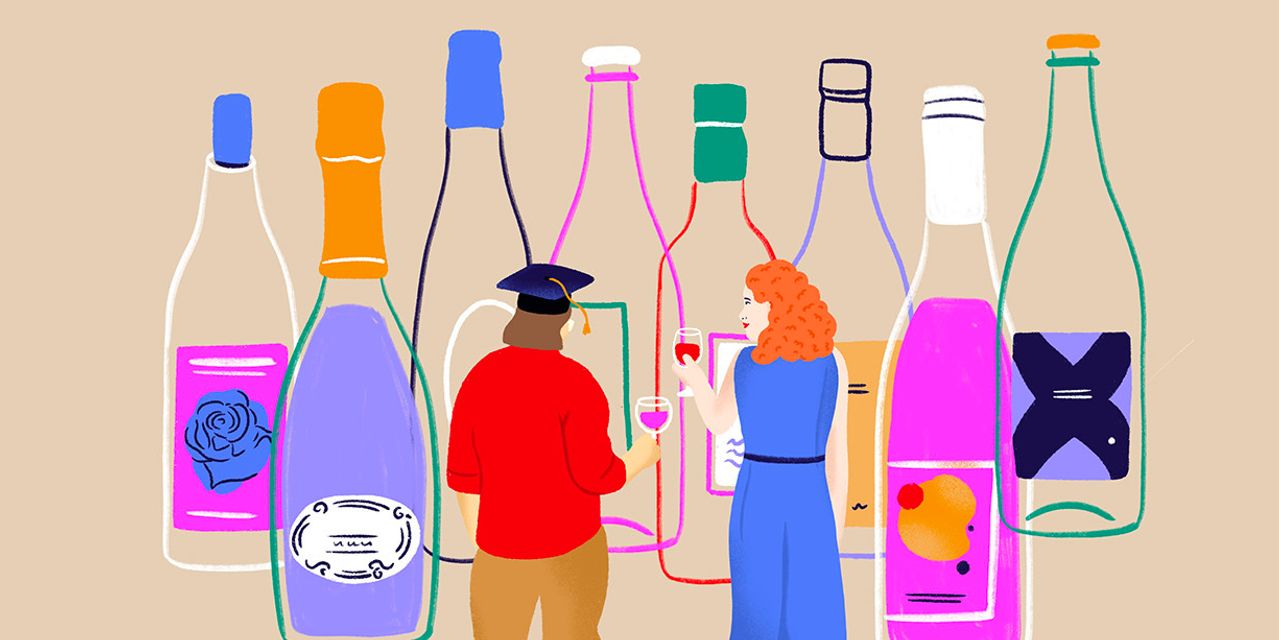The first in a three-part series on the fundamentals of wine appreciation.
A LIBERAL ARTS education fosters intellectual engagement and the development of critical thought, but it rarely provides insight into wine and food pairing, or how to find a good bottle in a wine shop.

So I offered my services as wine tutor to a recent college grad, Julian Pecht, the son of my dear friends Kathy and Michael Pecht. The 22-year-old magna cum laude classics major from New Jersey told me he occasionally drank wine with friends, but they rarely examined what they were drinking. “Wine isn’t something we talk about,” he said. He thought a measure of wine literacy might be useful in post-graduate life, however, and I thought that by teaching Julian some basics, I might help other aspiring oenophiles.
I decided the first segment should be an overview of key grapes, tasting terms and techniques. We met at my home and focused on six grape varieties: Chardonnay, Sauvignon Blanc, Riesling, Cabernet Sauvignon, Syrah and Pinot Noir. Five of the six varieties named here are French, but I chose bottles from several countries to emphasize that these grapes grow all over the world. And as they’re some of the most commonplace, I figured Julian had encountered at least one or two.
The wines I chose cost $15-$25 a bottle, except the 2018 Penfolds Bin 28 Kalimna South Australia Shiraz ($28), the sort of big, bold red I thought a young college grad would enjoy. The rest included wines from a few favorite producers: the 2019 Dönnhoff Nahe Riesling ($17), from Germany; 2019 Yves Martin Chavignol Sancerre ($22), from France; 2019 Drouhin-Vaudon Chablis ($23), also French; 2019 Argyle Willamette Valley Pinot Noir ($20), from Oregon; and 2018 Decoy Duckhorn Portfolio Cabernet Sauvignon ($15), from California. From my cellar, I brought up a bottle of another California wine, the 2018 Frank Family Vineyards Carneros Chardonnay, for comparison with the Chablis.
Julian arrived at 11 a.m. It’s best to taste wine in the morning, when the palate is freshest. I would have preferred an earlier start, but recent college grads and middle-aged wine columnists don’t keep the same hours. I was impressed, though, that Julian arrived at my house carrying a Moleskine notebook and a pen. The notebook was already crowded with notes about “The Iliad” and “The Odyssey” as well as jam-making and locations of the Asian supermarket chain H Mart across the U.S. Julian assured me there were plenty of pages left for wine.
“
‘I know there is good wine and bad wine, and red and white and also allegedly rosé.’
”
“I know there is good wine and bad wine, and red and white and also allegedly rosé,” Julian said. “Allegedly?” I asked. “My mom hates rosé, so I’ve never tasted it,” he said. He also shared that he avoided sparkling wine “on account of bubbles.”
I arranged the glasses on pieces of white paper, the better to assess the wines’ color. Information about age, texture and even alcohol content and grape variety can be obtained just by looking at the wine. The Dönnhoff Riesling was pale, almost translucent in the glass, which indicated it was young and free of oak: Fermenting and aging in oak barrels deepens the color of a white wine. The wine was also quite light-bodied and thus clearly lower in alcohol; a higher-alcohol white wine is more viscous, I noted, offering the California Chardonnay for comparison. I dropped one more tip: If you want to know whether a Riesling is dry or sweet, check the alcohol content, listed on the label. A truly dry Riesling is at least 11.5% alcohol. (The Dönnhoff was off-dry at 10.5%.)
When we took up our glasses, I demonstrated the correct way to hold them: not by the bowl but by the stem or the foot. It’s not only more elegant but, more important, it allows one to more easily swirl the wine inside. Swirling releases or “volatizes” aromatic compounds called esters. Sniffing, I noted, is best done in short bursts. What did Julian smell? “The first word that comes to mind is wine,” he replied.
We moved on to the next two whites. The subtle, mineral character of the Chablis seemed to perplex Julian. “The Chablis doesn’t register,” he said. “I think I might have to have more of it.” The oaky California Chardonnay made more of an impression. “It resembles Scotch,” Julian said—an apt observation, as both age in wood. The fact that Chardonnay can taste so different from one place to the next and with or without oak shows the grape’s flexibility. “It’s called the ‘winemaker’s grape’ for a reason,” I said.
SHARE YOUR THOUGHTS
What advice would you give to an aspiring wine connoisseur? Join the conversation below.
Julian recognized Sancerre—at least by the label. “It’s a wine my mom likes,” he said. I explained that Sancerre is a style of Sauvignon Blanc and one of most popular by-the-glass offerings at restaurants because it tends to be soft and approachable. Julian approved and even described its taste as “floral.” Dashing off notes, he asked, “Are tasting notes a marketing ploy?”
He was particularly interested in the sales and marketing of wine. Wine is, he said, a commodity after all—unlike, say, the ancient texts he studied. “Classic literature exists outside its net value,” Julian said. I argued that a wine could be both art and commodity, and suggested we turn to the reds.
Julian admitted to feeling intimidated by red wine, which seemed to him more complex. There do tend to be more components to the flavor and mouthfeel of reds. For instance, while all wines contain tannins—astringent compounds found in grape skins as well as oak—red wines have more. Syrah is particularly high in tannins thanks to the thickness of the grape’s skin and the barrels it’s typically fermented and aged in.
Pinot Noir, meanwhile, often acts as a bridge to red wine for white-wine drinkers—more approachable, with softer tannins than most reds. Yet Julian found the earthy nose (“dirt” was the word he used) on the 2019 Argyle Willamette Valley Pinot Noir a bit off-putting. He deemed the 2018 Decoy Duckhorn Portfolio Cabernet Sauvignon “flat”—which turned out to be his synonym for “dry.” I explained that among wine professionals, “flat” implies a lack of acidity—tantamount to lifelessness, as acidity is life in a wine. The Shiraz I thought he would like was too tannic for him, too overwhelming. “This wine needs food,” Julian said.
I assured him we would cover wine and food pairing in part two of our tutorial. As I sent Julian off with the partially drunk bottles from our first session, I promised there was still much to taste and explore. “The journey is the thing,” as Homer said.
Write to Lettie at wine@wsj.com
Copyright ©2020 Dow Jones & Company, Inc. All Rights Reserved. 87990cbe856818d5eddac44c7b1cdeb8













































